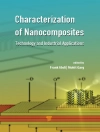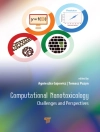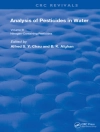Completely up-to-date, this is the first comprehensive monograph on metal oxide varistors with a focus on microstructure, conduction mechanisms, device failures, ageing, additive impacts and future varistor systems.
As such, it covers the fundamentals and applications of metal oxide varistors, including their macro-characteristics, microstructural properties and the device-internal physical and electrical mechanisms. The author reflects on the achievements made in varistor research and propose new approaches to analyze and predict the macro-characteristics, employing such methods as micro-contact measurements and numerical simulations. In addition, he looks at future directions for varistor research, such as Zn O varistors with a high voltage gradient and low residual voltage and further varistor types based on Ti O2 and Sn O2.
Spis treści
Preface xiii
Acknowledgments xv
1 Introduction of Varistor Ceramics 1
1.1 Zn O Varistors 1
1.2 Fabrication of Zn O Varistors 3
1.2.1 Preparation of Raw Materials 4
1.2.2 Sintering of Zn O Varistors 5
1.3 Microstructure 6
1.4 Typical Parameters of Zn O Varistors 7
1.5 History of Zn O Varistors 9
1.6 Applications of Zn O Varistors 12
1.7 Alternative Varistor Ceramics 17
1.8 Ceramic–Polymer Composite Varistors 18
References 22
2 Conduction Mechanisms of Zn O Varistors 31
2.1 Introduction 31
2.2 Basic Concepts in Solid-State Physics 33
2.2.1 Atomic Energy Level and Energy Band of Crystal 33
2.2.2 Metal, Semiconductor, and Insulator 35
2.2.3 Characteristics of Fermi–Dirac Function 37
2.2.4 Impurity and Defect Energy Level 38
2.3 Energy Band Structure of a Zn O Varistor 39
2.3.1 Energy Band Structure of a Zn O Grain 39
2.3.2 DSB of a Zn O Varistor 40
2.3.3 Microscopic Origin of DSB 41
2.3.4 Asymmetric I–V Characteristics of the DSB 43
2.4 Conduction Mechanism of a Zn O Varistor 45
2.4.1 Conduction Model Based on Thermionic Emission Process 46
2.4.2 Minority Carrier Generation Process 49
2.4.3 The Bypass Effect Model 51
2.5 Dielectric Characteristics of a Zn O Varistor 51
2.5.1 Explanation to Dielectric Properties of a Zn O Varistor 52
2.5.2 Effect of Interfacial Charge Relaxation on Conducting Behavior of Zn O Varistors Under Time-Varying Electric Fields 54
2.5.3 Determination of Barrier Height and Related Parameters 58
2.5.4 Determination of Deep Donor Level in the Zn O Varistor 59
2.5.5 Determination of Grain and Grain Boundary Conductivity 60
References 62
3 Tuning Electrical Characteristics of Zn O Varistors 67
3.1 Introduction 67
3.2 Liquid-Phase Fabrication 68
3.2.1 Microstructure of Zn O Varistor 68
3.2.2 Polymorph of Bismuth Oxide 71
3.2.3 Influence of Bi2O3 Concentration 72
3.2.4 Volatilization of Bismuth Oxide 72
3.3 Preparing and Sintering Techniques 74
3.3.1 Fabrication 74
3.3.2 Fabrication Stages 75
3.3.3 Effect of Pores 76
3.4 Role of Oxygen at the Grain Boundary 78
3.5 Dopant Effects 79
3.5.1 Effects of Additives 79
3.5.2 Donor Dopants 82
3.5.3 Acceptor Dopants 86
3.5.4 Amphoteric Dopants 87
3.5.4.1 Monovalent Dopants 88
3.5.4.2 Trivalent Dopants 89
3.5.5 Effects of Rare Earth Oxides 92
3.5.6 Dopants for Improving the Stability 93
3.5.7 Evidence for Hydrogen as a Shallow Donor 95
3.6 Role of Inversion Boundaries 95
3.7 High Voltage Gradient Zn O Varistor 98
3.8 Low Residual Voltage Zn O Varistor 101
3.8.1 Residual Voltage Ratio 101
3.8.2 Low Residual Voltage Zn O Varistors by Doping Al 103
3.8.3 Low Residual Voltage Zn O Varistors by Doping Ga 106
3.8.4 Low Residual Voltage Zn O Varistors with High Voltage Gradient 108
References 110
4 Microstructural Electrical Characteristics of Zn O Varistors 125
4.1 Introduction 125
4.2 Methods to Determine Grain Boundary Parameters 126
4.2.1 The Indirect Method 126
4.2.2 The Direct Microcontact Methods 126
4.3 Statistical Characteristics of Grain Boundary Parameters 129
4.3.1 Nonuniformity of Barrier Voltages 129
4.3.2 Distribution of Barrier Voltage 131
4.3.3 Distribution of Nonlinear Coefficient 132
4.3.4 Distribution of Leakage Current Through Grain Boundary 133
4.3.5 Discussion on Microcontact Measurement 133
4.4 Classification of Grain Boundaries 134
4.5 Other Techniques to Detect Microstructurally Electrical Properties of Zn O Varistors 137
4.5.1 Scanning Probe Microscopy-Based Techniques 137
4.5.2 Galvanic Determination of Conductive Areas on a Varistor Surface 139
4.5.3 Line Scan Determination of Differences in Breakdown Voltage Within a Varistor 141
4.5.4 Current Images in SEM 141
4.6 Test on Fabricated Individual Grain Boundary 142
4.6.1 Thin Film Approach 143
4.6.2 Surface In-Diffusion Approach 143
4.6.3 Bicrystal Approach 143
References 145
5 Simulation on Varistor Ceramics 149
5.1 Introduction 149
5.2 Grain Boundary Model 151
5.2.1 I–V Characteristic Model of Grain Boundary 151
5.2.2 GB Model Considering Conduction Mechanism 154
5.3 Simulation Model of I–V Characteristics 159
5.3.1 Simple 2D Simulation Model 159
5.3.2 2D Simulation Models Based on the Voronoi Network 161
5.3.3 Consideration on Pores and Spinels 164
5.3.4 Algorithm to Solve Equivalent Circuit 165
5.3.5 Model Verification 169
5.4 Simulation Model for Thermal Characteristics 170
5.4.1 Thermal Conduction Analysis 171
5.4.2 Pulse-Induced Fracture Analysis 173
5.5 Simulations on Different Phenomena 174
5.5.1 Simulation on Microstructural Nonuniformity 174
5.5.2 Simulation on Current Localization Phenomenon 175
5.5.3 Influence of Microstructural Parameters on Bulk Characteristics 179
5.5.3.1 Influence of Zn O Grain Parameters 180
5.5.3.2 Influence of Grain Boundary Parameters 183
5.5.4 Influential Factors on Residual Voltage Ratio 186
References 188
6 Breakdown Mechanism and Energy Absorption Capability of Zn O Varistor 193
6.1 Introduction 193
6.2 Impulse Failure Modes of Zn O Varistors 194
6.3 Mechanisms of Puncture and Fracture Failures 197
6.3.1 Mechanisms of Puncture Failure 197
6.3.2 Mechanism of Fracture Failure 201
6.4 Simulation of Puncture and Fracture Failures 204
6.4.1 Puncture Destruction Simulation 204
6.4.1.1 Puncture Simulation in Microstructure 206
6.4.2 Cracking Failure Simulation in Microstructure 208
6.5 Thermal Runaway 209
6.5.1 Power Loss of Zn O Varistor 210
6.5.2 Thermal Runaway Mechanism 210
6.5.3 Tests to Ensure the Thermal Stability Characteristics 213
6.6 Influences of Different Factors on Failures of Zn O Varistors 213
6.6.1 Influence of Microstructural Nonuniformity 213
6.6.2 Influence of Electrical Nonuniformity in Microstructure 216
6.6.3 Simulation Analysis on Breakdown Modes 217
6.7 Influential Factors on Energy Absorption Capability 218
6.7.1 Influence of the Applied Current 218
6.7.2 Influence of Varistor Cross-sectional Area 221
6.7.3 Simulation Analysis on Surge Energy Absorption Capability 221
6.8 Discussions on Energy Absorption Capability 225
6.8.1 Energy Absorption Capability Determined by Fracture Failure 225
6.8.2 Energy Absorption Capability Determined by Puncture Failure 226
6.8.3 Discussion on Nonuniformity of Energy Absorption Capability 228
6.8.4 Additives Effect on Energy Absorption Capability 229
6.8.5 Other Measures to Improve Energy Absorption Capability 230
References 230
7 Electrical Degradation of Zn O Varistors 235
7.1 Introduction 235
7.2 Degradation Phenomena of Zn O Varistors 237
7.2.1 Degradation Phenomena of the Varistor Bulk 237
7.2.2 Degradation of Grain Boundary 242
7.2.3 Pulse Degradation Characteristics 245
7.2.4 Topographic Information for Degradation Analysis 247
7.3 Migration Ions for the Degradation of Zn O Varistors 249
7.3.1 Grain Boundary Defect Model 249
7.3.2 Experimental Proof of Ion Migration 251
7.3.3 Identification of Dominant Mobile Ions 252
7.3.4 Three-Dimensional Extension 256
7.4 Degradation Mechanism of Zn O Varistors 257
7.4.1 DC Degradation Mechanism 258
7.4.2 AC Degradation Mechanism 258
7.4.3 Nonuniform Degradation Mechanism 260
7.4.4 Pulse Degradation of Zn O Varistors 262
7.4.4.1 Degradation Mechanism Under Impulse Current 263
7.4.4.2 Superimposing Degradation 264
7.5 Role of Interior Microcracks on Degradation 266
7.6 Antidegradation Measures 267
7.6.1 Specific Preparation Procedures 268
7.6.2 Optimization of Formula 269
7.6.2.1 Dopant Effects on Improving AC Degradation Characteristics 270
7.6.2.2 Dopant Effects on Improving Impulse Degradation Property 271
References 272
8 Praseodymium/Vanadium/Barium-Based Zn O Varistor Systems 281
8.1 Praseodymium System 281
8.1.1 Doping Effects 281
8.1.2 Effect of Sintering Processes 285
8.1.3 High-Voltage Applications 288
8.1.4 Low-Voltage Applications 288
8.2 Vanadium System 289
8.2.1 Doping Effects 290
8.2.2 Electrical Characteristics 291
8.2.3 Microstructural Characteristics 292
8.2.4 Effects of Vanadium Oxide on Grain Growth 294
8.3 Barium System 295
8.3.1 Preparation and Electrical Characteristics 295
8.3.2 Microstructural Characteristics 296
8.3.3 Improving Stability Against Moisture 298
8.4 Zn O–Glass Varistor 298
References 300
9 Fabrications of Low-Voltage Zn O Varistors 307
9.1 Introduction 307
9.2 Exaggerating Grain Growth by Seed Grains 308
9.3 Synthesis of Nanocrystalline Zn O Varistor Powders 309
9.3.1 Gas-Phase Processing Methods 309
9.3.2 Combustion Synthesis 311
9.3.3 Sol–Gel Methods 311
9.3.4 Solution-Coating Method 315
9.4 Nanofillers in Zn O Varistor Ceramics 320
9.5 Sintering Techniques to Control Grain Growth 321
9.5.1 Step-sintering Approach 321
9.5.2 Microwave Sintering Method 322
9.5.3 Spark Plasma Sintering Technique 324
References 327
10 Titanium-Based Dual-function Varistor Ceramics 335
10.1 Sr Ti O3 Varistors 335
10.1.1 Introduction 335
10.1.2 Microstructure of Sr Ti O3 Varistors 336
10.1.3 Preparation of Sr Ti O3 Varistors 336
10.1.4 Performance of Sr Ti O3 338
10.1.5 Conduction Mechanism of Sr Ti O3 339
10.2 Ti O2-Based Varistors 341
10.2.1 Introduction 341
10.2.2 Preparation of Ti O2-Based Varistors 342
10.2.3 Mechanism of Ti O2 Capacitor–Varistor Ceramics 342
10.2.4 Doping of Ti O2-Based Varistors 343
10.2.4.1 Acceptor-Doped Ti O2-Based Varistors 343
10.2.4.2 Donor-Doped Ti O2-Based Varistors 344
10.2.4.3 Codoping Effects of Acceptor and Donor Dopants 345
10.2.4.4 Sintering Additives in Ti O2-Based Varistors 347
10.2.5 Development of Ti O2-Based Varistors 348
10.3 Ca Cu3 Ti4O12 Ceramics 348
10.3.1 Introduction 348
10.3.2 Structure of CCTO 349
10.3.2.1 Crystal Structure 349
10.3.2.2 Phase and Microstructure 350
10.3.3 Performances of CCTO Ceramics 352
10.3.3.1 Nonohmic Current–Voltage Characteristic 352
10.3.3.2 Colossal Permittivity 354
10.3.3.3 Dielectric Loss 357
10.3.4 Mechanism 358
10.3.4.1 IBLC Model 358
10.3.4.2 Conducting Mechanism 362
10.3.4.3 Polarization Mechanism of Grains 364
10.3.4.4 A Polaronic Stacking Fault Defect Model 365
10.3.5 Role of Dopants 366
10.3.5.1 Role of Doping Cu O 366
10.3.5.2 Doping Mechanisms to Tune CCTO Performances 368
10.4 Ba Ti O3 Varistors of PTCR Effect 375
10.4.1 Introduction 375
10.4.2 Doping Effects 377
10.4.3 Preparation of Ba Ti O3 Ceramics 379
10.4.4 PTCR Effect of Ba Ti O3 Ceramics 381
10.4.5 Varistor Characteristics of Ba Ti O3 Ceramics 384
References 386
11 Tin Oxide Varistor Ceramics of High Thermal Conductivity 407
11.1 Preparation of Sn O2-Based Varistors 407
11.2 Electrical Performances of Sn O2-Based Varistors 410
11.3 Mechanism of Sn O2-Based Varistors 414
11.3.1 Formation of Grain Boundary Potential Barrier 414
11.3.2 Atomic Defect Model 415
11.3.3 Admittance Spectroscopy Analysis 417
11.3.4 Capacitance–Voltage Analysis 420
11.3.5 Effect of Thermal Treatment 421
11.4 Role of Dopants in Tuning Sn O2-Based Varistors 423
11.4.1 Dopants for Densifying Sn O2-Based Varistors 423
11.4.2 Acceptor Doping 424
11.4.3 Donor Doping 427
11.5 Thermal Performances 429
11.6 Degradation Behaviors 431
11.7 Development of Sn O2-Based Varistors 432
References 434
12 WO3-Based Varistor Ceramics of Low Breakdown Voltage 441
12.1 Introduction 441
12.2 Tungsten Oxide 442
12.3 Preparation of WO3-Based Varistors 444
12.4 Electrical Performances 446
12.5 Improving the Electrical Stability 448
12.6 Mechanism Model of WO3-Based Varistors 449
12.7 Doping Effects 452
12.7.1 The Addition of Rare Earth Oxides 452
12.7.2 The Addition of Cu O 453
12.7.3 The Addition of Al2O3 454
12.7.4 The Addition of Ti O2 455
12.7.5 The Addition of Other Additives 455
References 456
Index 461
O autorze
Jinliang He is the Chang Jiang Scholars Distinguished Professor of China’s Ministry of Education with the Department of Electrical Engineering of the Tsinghua University, Beijing, China. Currently Jinliang He is the Chair of the High Voltage and Insulation Technology Research Institute at the Tsinghua University. His research interests cover dielectric materials and electroceramics, transient electromagnetics and electromagnetic compatibility in power systems and electronic systems as well as advanced power transmission technology. During 2014 to 2018, he had been assigned by China Science and Technology Ministry as the Chief Scientist in charge of a 5-year China National Fundamental Research Project. He has co-authored more than 310 papers in peer-reviewed international journals and transactions and more than 200 papers in refereed Chinese-language journals. He has published 5 academic monographs, and 2 textbooks. He was elected a Fellow of IEEE in 2007 and a Fellow of IET in 2011 for his contribution to lightning protection and grounding technology in power transmission system , and a Fellow of HPEM in 2018 for contributions to the understanding and protection of lightning discharges and electromagnetic effects. Jinliang He received the 'Technical Achievement Award’ and 'Certificate of Acknowledgement’ of the IEEE-EMC Society, respectively in 2010 and 2011, the Hoshino Prize (6th session) by the Institute of Electrical Installation Engineers of Japan in 2013, the Distinguished Contribution Award from Asia-Pacific International Conference on Lightning in 2015, the Rudolf Heinrich Golde Award from International Conference on Lightning Protection in 2016, and 2018 IEEE Herman Halperin Electric Transmission and Distribution Award for contributions to lightning protection of power transmission systems, including advancing analytic methods and innovation in line surge arresters. He is the recipients of two Chinese national awards for scientific and technological progress, a Chinese national invention award, and 20 provincial and ministerial science and technology awards.












